1993 CHEVROLET CAMARO tire size
[x] Cancel search: tire sizePage 217 of 358
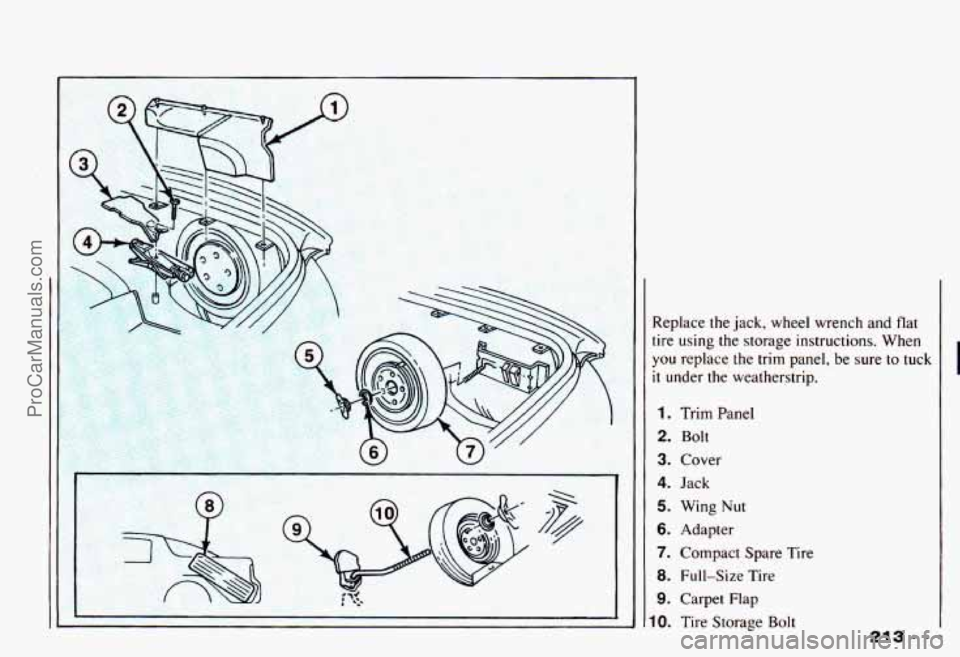
J
Replace the jack, wheel wrench and flat
tire using the storage instructions. When
you replace the trim panel, be sure to tuck
it under the weatherstrip.
1. Trim Panel
2. Bolt
3. Cover
4. Jack
5. Wing Nut
6. Adapter
7. Compact Spare Tire
8. Full-Size Tire
9. Carpet Flap
IO. Tire Storage Bolt
2
ProCarManuals.com
Page 218 of 358
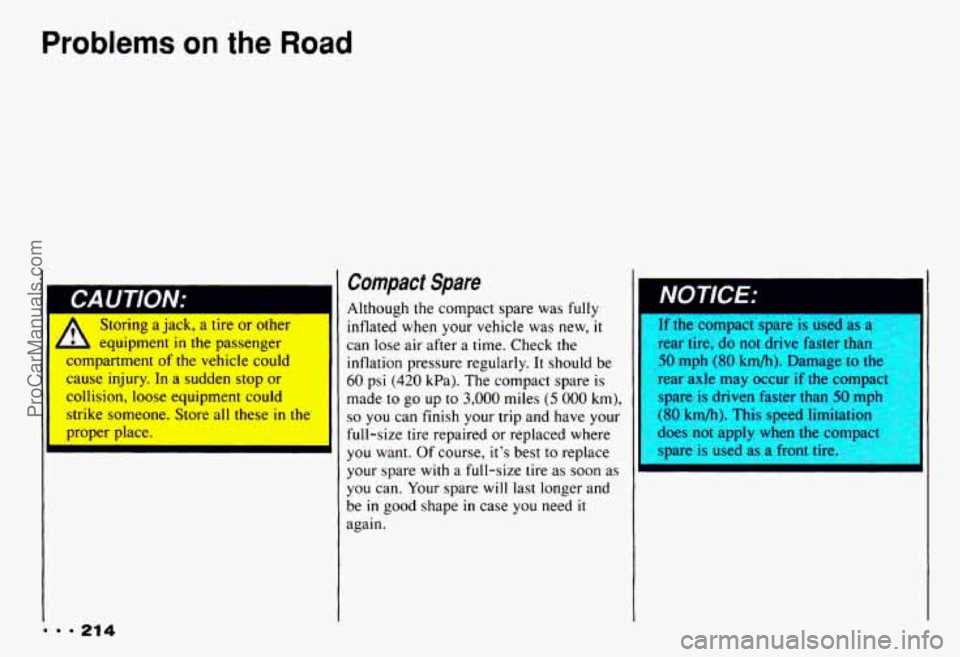
Problems on the Road
II , Storing aJacK, a tlre or otner I
4 equipment in the passenger
Ldmpartment of the vehicle could
cause injury. In a sudden
stop or
collision, loose equipment could
strike someone. Store all these
in the
proper place.
Compact Spare
Although the compact spare was fully
inflated when your vehicle was new, it
can lose air after a time. Check the
inflation pressure regularly.
It should be
60 psi (420 kPa). The compact spare is
made to go up to 3,000 miles (5 000 km),
so you can finish your trip and have your
full-size tire repaired or replaced where
you want. Of course,
it’s best to replace
your spare
with a full-size tire as soon as
you can. Your spare
will last longer and
be
in good shape in case you need it
again.
NOTICE:
lr tne compact spare 1s use0 as a
rear tire, do not drive faster than
50 mph (80 km/h). Damage to the
rear axle may occur
if the compac
snare
is driven faster than 50 mnh
( 0 km/h). This speed limitatia
does
not apply when the COI
ware is used as a front tire.
ProCarManuals.com
Page 259 of 358
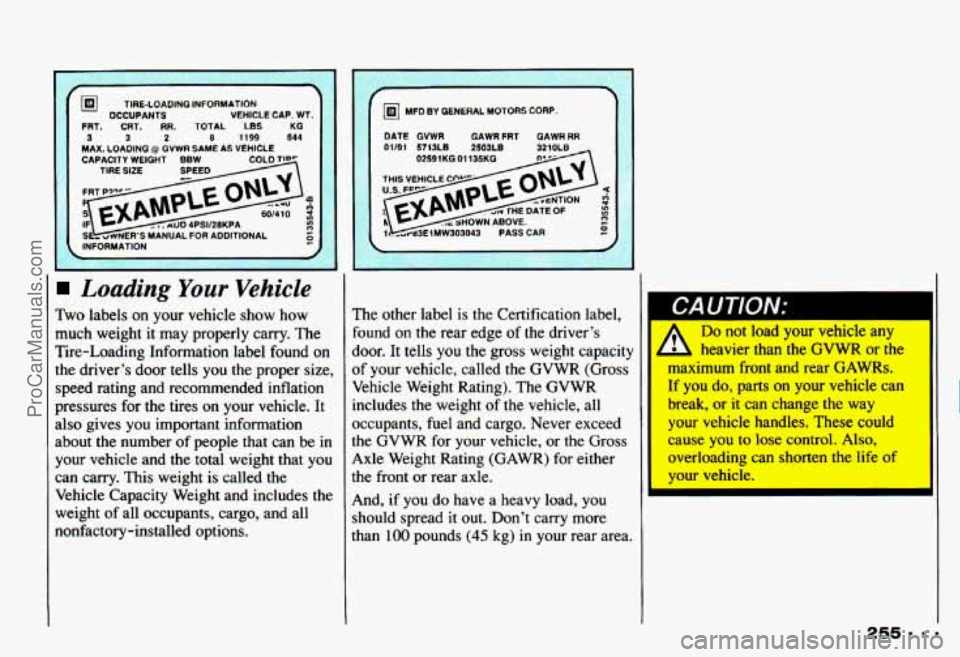
CAPACITY WEIGHT BBW TIRE SIZE
INFORMATION
Loading Your Vehicle
Two labels on your vehicle show how
much weight it may properly carry. The
Tire-Loading Information label found on
the driver’s door tells
you the proper size,
speed rating and recommended inflation
pressures for
the tires on your vehicle. It
also gives you important information
about the number of people that can be in
your vehicle and the total weight that
you
can carry. This weight is called the
Vehicle Capacity Weight and includes the
weight of all occupants, cargo, and all
nonfactory-installed options.
DATE GVWR GAWRFRT GAWR RR 01/91 5713LB ZS03LB <. .
v)
The other label is the Certification label,
found on
the rear edge of the driver’s
door. It tells you the gross weight capacity
of your vehicle, called the GVWR (Gross
Vehicle Weight Rating). The GVWR
includes the weight of the vehicle, all
occupants, fuel and cargo. Never exceed
the GVWR for your vehicle,
or the Gross
Axle Weight Rating (GAWR) for either
the front or rear axle.
And,
if you do have a heavy load, you
should spread it out. Don’t carry more
than
100 pounds (45 kg) in your rear area.
Do not load your vehicle any
- L heavier than the GVWR or the
maximum front and rear GAWRs.
If you do, parts on your vehicle can
break, or
it can change the way
your vehicle handles. These could
cause you to lose control.
Also,
overloading can shorten the life of , ,
II
ProCarManuals.com
Page 262 of 358
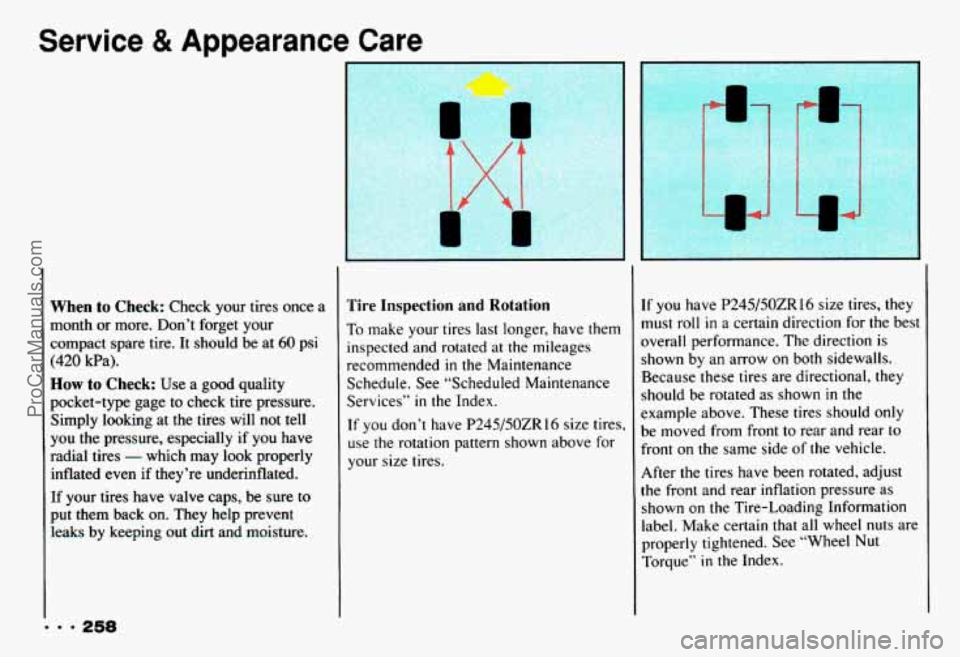
Service & Appearance Care
9 9 9 258
When to Check: Check your tires once a
month
or more. Don’t forget your
compact spare tire. It should be at
60 psi
(420 kPa).
How to Check: Use a good quality
pocket-type gage to check tire pressure.
Simply looking at the tires will not tell
you the pressure, especially if you have
radial tires
- which may look properly
inflated even if they’re underinflated.
If your tires have valve caps, be sure to
put them back on. They help prevent
leaks by keeping out
dirt and moisture.
L
’
Tire Inspection and Rotation
To make your tires last longer, have them
inspected and rotated at the mileages
recommended
in the Maintenance
Schedule. See “Scheduled Maintenance
Services”
in the Index.
If you don’t have
P245/50ZR 16 size tires,
use the rotation pattern shown above for
your size tires. If
you have P245/50ZR16 size tires, they
must roll
in a certain direction for the best
overall performance. The direction is
shown by an arrow on both sidewalls.
Because these tires are directional, they
should
be rotated as shown in the
example above. These tires should only
be moved from front to rear and rear to
front on the same side of the vehicle.
After the tires have been rotated, adjust
the front and rear inflation pressure as
shown on the Tire-Loading Information
label. Make certain that all wheel nuts are
properly tightened. See “Wheel
Nut
Torque” in the Index.
ProCarManuals.com
Page 263 of 358
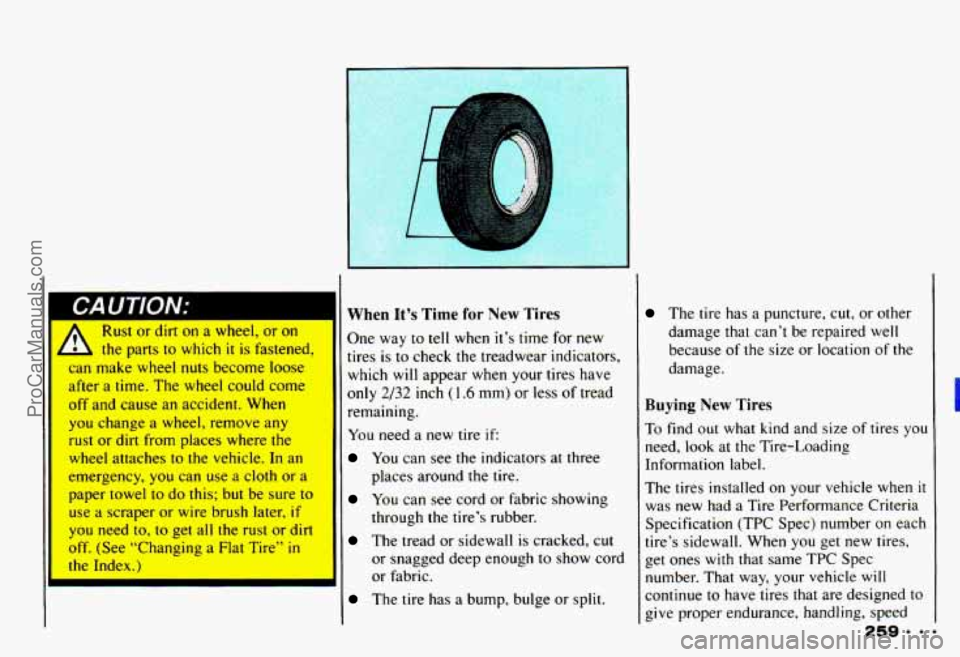
Rust or dirt on a wheel, or on
- the parts to which it is fastened,
can make wheel
nuts become loose
after a time. The wheel could come
off and cause an accident. When
you change a wheel, remove any
rust
or dirt from places where the
wheel attaches
to the vehicle. In an
emergency,
you can use a cloth or a
paper towel to do this; but be sure to
use a scraper
or wire brush later, if
you need to, to get all the rust or dirt
off. (See “Changing
a Flat Tire” in
When It’s Time for New Tires
One way to tell when it’s time for new
tires
is to check the treadwear indicators,
which will appear when your tires have
only
2/32 inch (1.6 mm) or less of tread
remaining.
You need a new tire if:
You can see the indicators at three
places around the tire.
through the tire’s rubber.
or snagged deep enough to show cord
or fabric.
You can see cord or fabric showing
The tread or sidewall is cracked, cut
The tire has a bump, bulge or split.
The tire has a puncture, cut, or other
damage that can’t be repaired well
because
of the size or location of the
damage.
Buying New Tires
To find out what kind and size of tires you
need, look at the Tire-Loading
Information label.
The tires installed on your vehicle when
it
was new had a Tire Performance Criteria
Specification (TPC Spec) number
on each
tire’s sidewall. When you get new tires,
get ones
with that same TPC Spec
number. That way, your vehicle
will
continue to have tires that are designed to
give proper endurance, handling, speed
ProCarManuals.com
Page 264 of 358
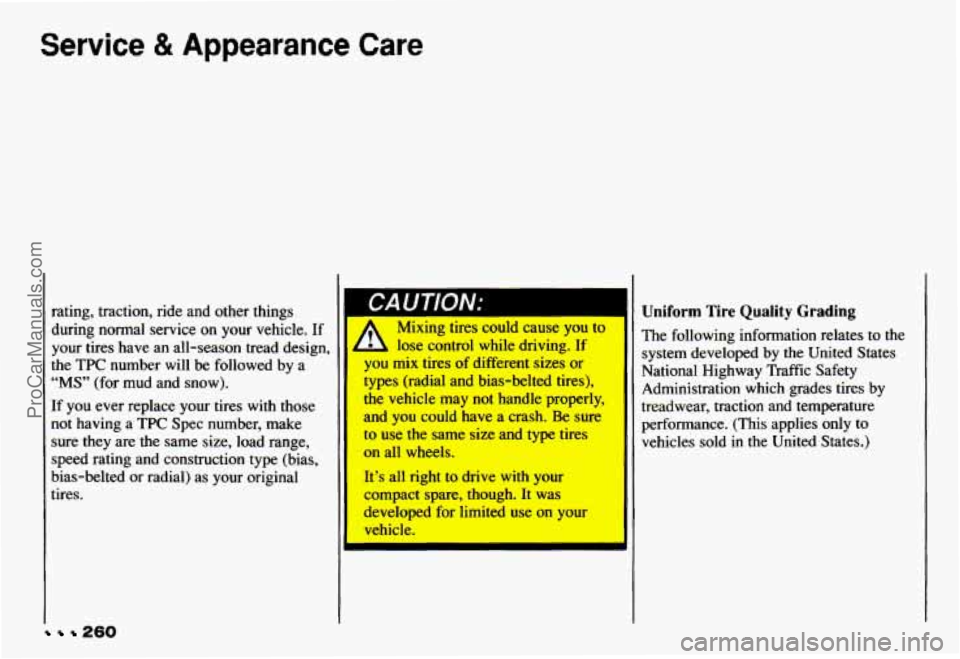
Service & Appearance Care
I
1
260
rating, traction, ride and other things during normal service on your vehicle. If
your tires have an all-season tread design,
&he
TPC number will be followed by a
“MS” (for mud and snow).
If you ever replace your tires with those
not having a TPC Spec number, make
sure they are the same size, load range, speed rating and construction type (bias,
bias-belted or radial) as your original
tires.
I bA u I /w/v.-
Mixing tires could cause you to
you mix tires of different sizes or
the vehicle may not handle properly,
and you could have a crash. Be sure
to use the same size and type tires
on all wheels,
It’s all right to drive with your
compact spare, though. It was
developed for limited use on your
vehicle.
typs
(radial ad bias-belted tires),
Uniform Tire Quality Grading
The following information relates to the
system developed
by the United States
National Highway Traffic Safety
Administration which grades tires by
treadwear, traction and temperature
performance.
(This applies only to
vehicles sold in the United States.)
ProCarManuals.com
Page 268 of 358
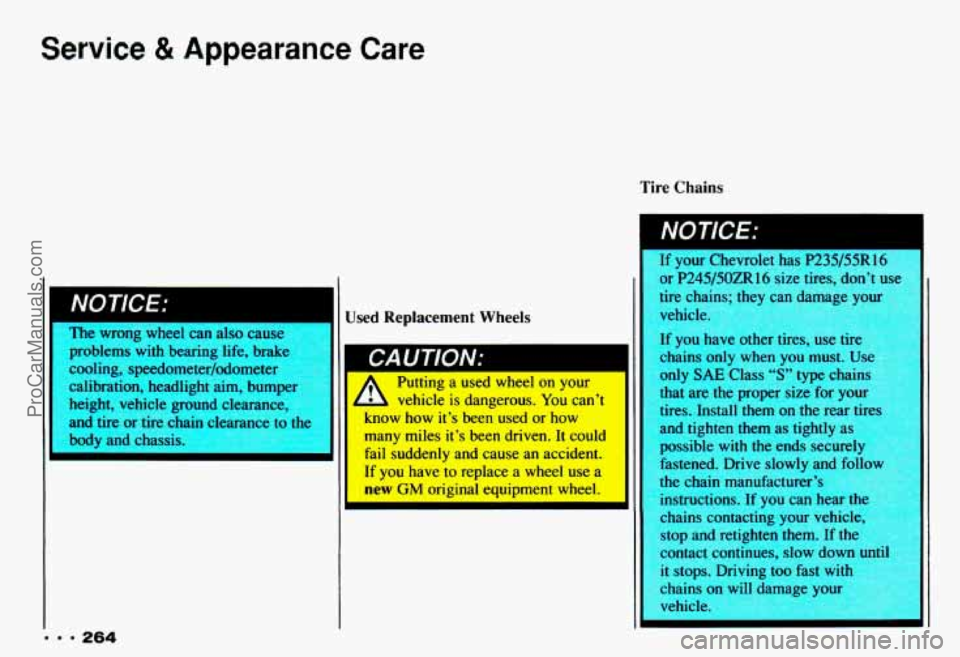
Service & Appearance Care
Tire Chains
IL
The wrong wheel can also cause
problems with bearing life, brake
cooling, speedometer/odometer
y!g@
calibration, headlight aim, bumper32
‘ i.i _. /8*
. .I )
height, vehicle ground clearance,
and tire or tire chain clearance to the
body and chassis. 1
... 264
Used Replacement Wheels
ruwllg it uscu WIIGGI UII yuul
vehicle is dangerous. You can’t
nnOW how it’s been used or how
many miles it’s been driven. It could
fail suddenly and cause an accident.
If you have to replace a wheel use a
new GM original equipment wheel.
Ib
If your Chevrolet has P235/55R16
or
P245/50ZRlf; cize tire. don’t 11c~ I
tire chains: the --In dm e vow I
I
vehicle.
If
you ,.-ve other tires, “st; LIIC
chains only when you must. Use
only
SAE Class “S” type chains
that are the proper size for
y
tires. Install them on the rear tires
and tighten them as tightly as
possible
with the ends securel)
fastened. Drive slowly and
folio
stop and retighten them. If the I
the chain manufacturer’s
instructions.
If you can hear th
chains contacting your vehicle
contact continues, slow down until
I
it stops. Driving too fast wit
chains on will damage yourg
vchicle.
I
ProCarManuals.com
Page 278 of 358
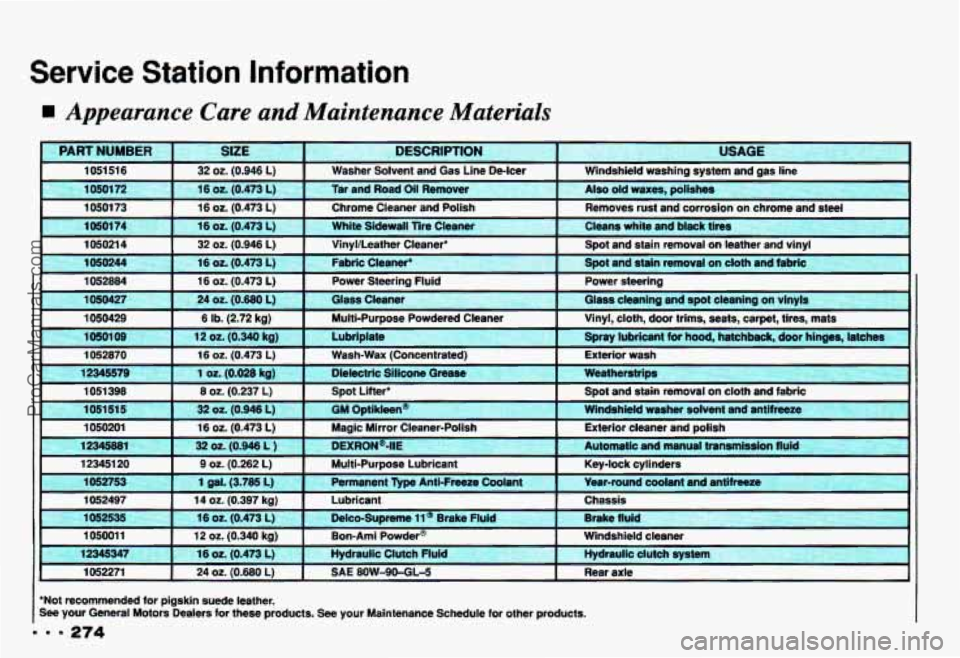
Service Station Information
Appearance Care and Maintenance Muterials
~
PART NUMBER
USAGE DESCRIPTION SIZE
1051 51 6
Removes rust and corrosion on chrome and steel
Chrome Cleaner
and Polish 16 oz. (0.473 L) 10501 73
Also old waxes, polishes
Tar and Road Oil Remover 16 oz. (0.473 L) 1 0501 72
Windshield washing system and gas line
Washer Solvent and Gas Line De-lcer 32 02. (0.946 L)
lo501 74 Cleans white and black tires
White Sidewall Tire Cleaner 16 02. (0.473 L)
105021 4
Vinyl, cloth, door trims, seats, carpet, tires, mats
Multi-Purpose Powdered Cleaner 6 Ib. (2.72 kg) 1050429
Glass cleaning and
spot cleaning on vinyls
Glass Cleaner 24 oz. (0.680 L) 1050427
Power
steering
Power Steering Fluid 16 oz. (0.473 L) 1052884
Spot and stain removal on cloth and fabric
Fabric Cleaner' 16 02. (0.473 L) 1050244
Spot and stain removal on leather and vinyl
VinyVLeather Cleaner' 32 02. (0.946 L)
lo501 09 Spray lubricant for hood, hatchback, door hinges, latches
Lubriplate 12 02. (0.340 kg)
1052870
Weatherstrips
Dielectric
Silicone Grease 1 oz. (0.028 kg) 12345579
Exterior wash
Wash-Wax (Concentrated) 16 02. (0.473 L)
1 051 398 Spot and stain removal on cloth and fabric
Spot Lifter' 8 02. (0.237 L)
1050201 16 oz. (0.473 L)
Key-lock cylinders
Multi-Purpose Lubricant
9 02. (0.262 L) 123451 20
Automatic and manual transmission
fluid DEXRON@-IIE 32 02. (0.946 L ) 12345881
Exterior cleaner and polish
Magic Mirror Cleaner-Polish
1051 51 5 Windshield washer solvent and antifreeze
GM Optikleen" 32 oz. (0.946 L)
1052753
Brake fluid Delco-Supreme 11 @ Brake Fluid 16 02. (0.473 L) 1052535
Chassis
Lubricant 14 02. (0.397 kg) 1052497
Year-round coolant and antifreeze
Permanent Type Anti-Freeze Coolant 1 gal. (3.785 L)
105001 1 Windshield cleaner Eon-Ami Powder@ 12 02. (0.340 kg)
12345347
1052271 Hydraulic clutch system
Hydraulic Clutch
Fluid 16 oz. (0.473 L)
Rear axle SAE 80W-9O-GLb 24 02. (0.680 L) J
*Not recommended for pigskin suede leather.
See your General Motors Dealers for these products. See your Maintenance Schedule for other products.
ProCarManuals.com